Organisational Behaviour: Culture, Motivation, and Teams Report
VerifiedAdded on 2020/10/05
|17
|5104
|310
Report
AI Summary
This report examines organisational behaviour within the context of A David & Co Limited, a UK-based food and beverage company. It delves into the influence of organisational culture, power dynamics, and politics on individual and team performance, including Handy's typology of cultures (power, task, role, and person cultures) and Raven and French's power types (reward, coercive, and referent power). The report further analyses content and process theories of motivation, such as Maslow's hierarchy of needs and Vroom's expectancy theory, and discusses the impact of globalisation on the workforce. The report also covers different types of teams, factors contributing to team effectiveness, and concepts of organisational behaviour in relation to the path-goal theory. The report concludes with the importance of motivation techniques and their role in enhancing employee performance and productivity within the organisation.
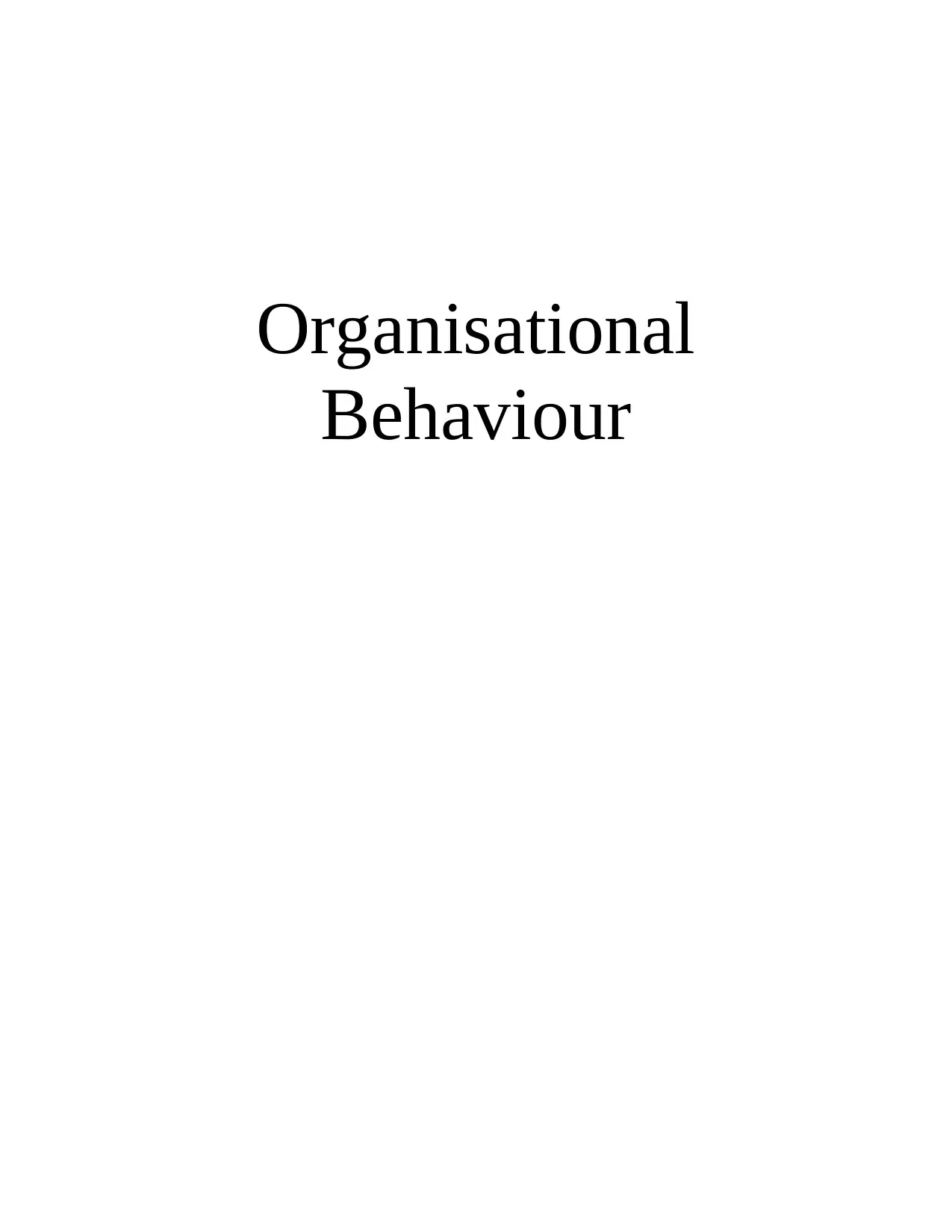
Organisational
Behaviour
Behaviour
Paraphrase This Document
Need a fresh take? Get an instant paraphrase of this document with our AI Paraphraser
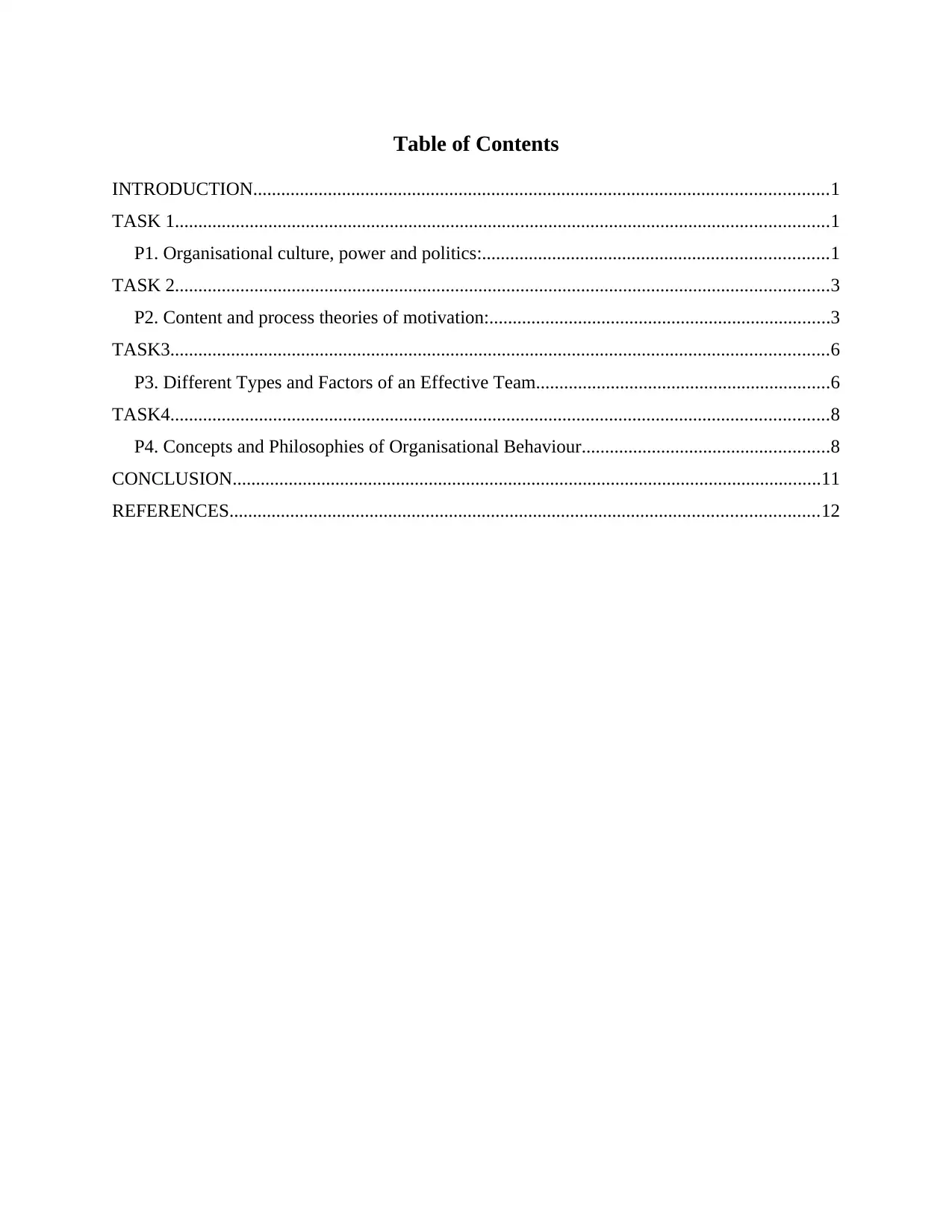
Table of Contents
INTRODUCTION...........................................................................................................................1
TASK 1............................................................................................................................................1
P1. Organisational culture, power and politics:..........................................................................1
TASK 2............................................................................................................................................3
P2. Content and process theories of motivation:.........................................................................3
TASK3.............................................................................................................................................6
P3. Different Types and Factors of an Effective Team...............................................................6
TASK4.............................................................................................................................................8
P4. Concepts and Philosophies of Organisational Behaviour.....................................................8
CONCLUSION..............................................................................................................................11
REFERENCES..............................................................................................................................12
INTRODUCTION...........................................................................................................................1
TASK 1............................................................................................................................................1
P1. Organisational culture, power and politics:..........................................................................1
TASK 2............................................................................................................................................3
P2. Content and process theories of motivation:.........................................................................3
TASK3.............................................................................................................................................6
P3. Different Types and Factors of an Effective Team...............................................................6
TASK4.............................................................................................................................................8
P4. Concepts and Philosophies of Organisational Behaviour.....................................................8
CONCLUSION..............................................................................................................................11
REFERENCES..............................................................................................................................12

⊘ This is a preview!⊘
Do you want full access?
Subscribe today to unlock all pages.

Trusted by 1+ million students worldwide
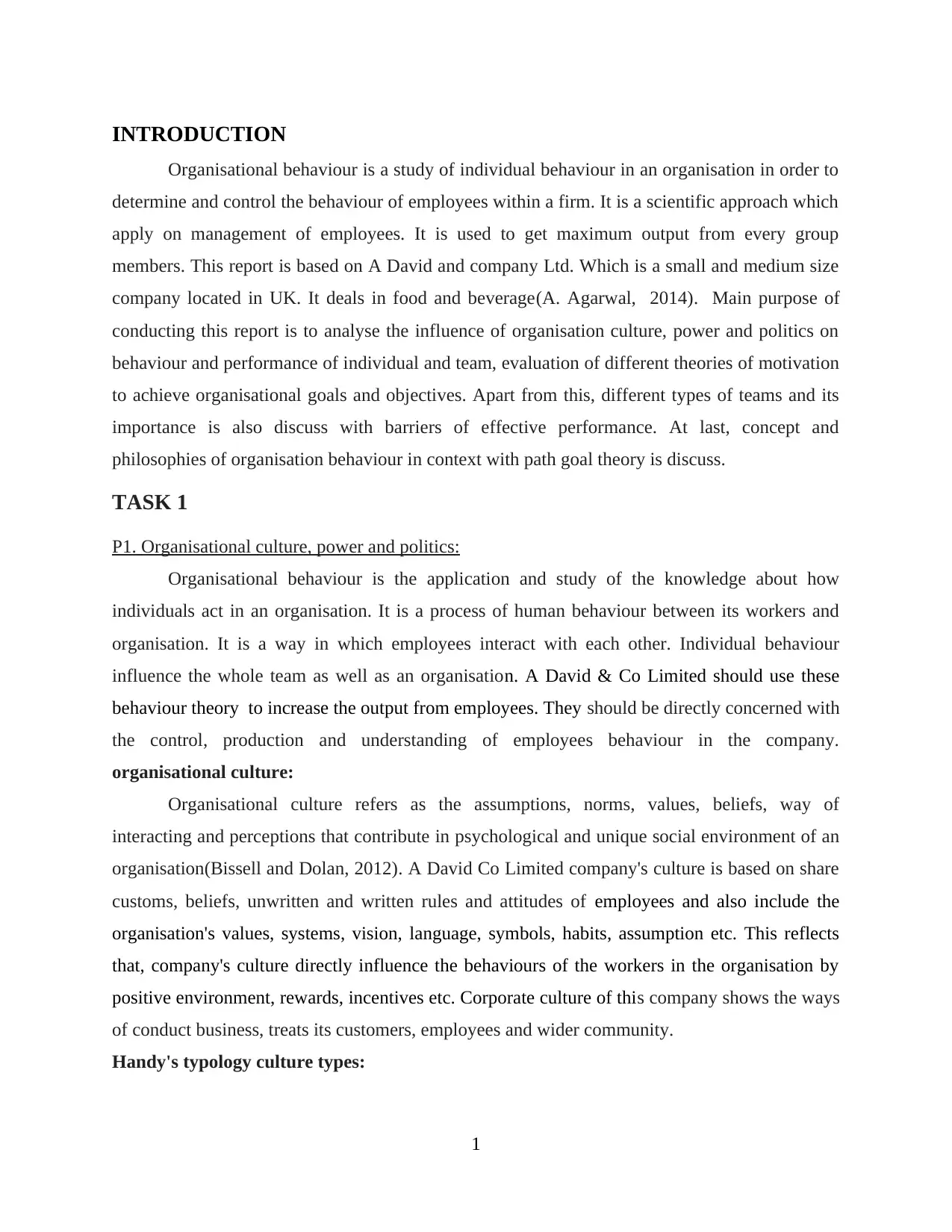
INTRODUCTION
Organisational behaviour is a study of individual behaviour in an organisation in order to
determine and control the behaviour of employees within a firm. It is a scientific approach which
apply on management of employees. It is used to get maximum output from every group
members. This report is based on A David and company Ltd. Which is a small and medium size
company located in UK. It deals in food and beverage(A. Agarwal, 2014). Main purpose of
conducting this report is to analyse the influence of organisation culture, power and politics on
behaviour and performance of individual and team, evaluation of different theories of motivation
to achieve organisational goals and objectives. Apart from this, different types of teams and its
importance is also discuss with barriers of effective performance. At last, concept and
philosophies of organisation behaviour in context with path goal theory is discuss.
TASK 1
P1. Organisational culture, power and politics:
Organisational behaviour is the application and study of the knowledge about how
individuals act in an organisation. It is a process of human behaviour between its workers and
organisation. It is a way in which employees interact with each other. Individual behaviour
influence the whole team as well as an organisation. A David & Co Limited should use these
behaviour theory to increase the output from employees. They should be directly concerned with
the control, production and understanding of employees behaviour in the company.
organisational culture:
Organisational culture refers as the assumptions, norms, values, beliefs, way of
interacting and perceptions that contribute in psychological and unique social environment of an
organisation(Bissell and Dolan, 2012). A David Co Limited company's culture is based on share
customs, beliefs, unwritten and written rules and attitudes of employees and also include the
organisation's values, systems, vision, language, symbols, habits, assumption etc. This reflects
that, company's culture directly influence the behaviours of the workers in the organisation by
positive environment, rewards, incentives etc. Corporate culture of this company shows the ways
of conduct business, treats its customers, employees and wider community.
Handy's typology culture types:
1
Organisational behaviour is a study of individual behaviour in an organisation in order to
determine and control the behaviour of employees within a firm. It is a scientific approach which
apply on management of employees. It is used to get maximum output from every group
members. This report is based on A David and company Ltd. Which is a small and medium size
company located in UK. It deals in food and beverage(A. Agarwal, 2014). Main purpose of
conducting this report is to analyse the influence of organisation culture, power and politics on
behaviour and performance of individual and team, evaluation of different theories of motivation
to achieve organisational goals and objectives. Apart from this, different types of teams and its
importance is also discuss with barriers of effective performance. At last, concept and
philosophies of organisation behaviour in context with path goal theory is discuss.
TASK 1
P1. Organisational culture, power and politics:
Organisational behaviour is the application and study of the knowledge about how
individuals act in an organisation. It is a process of human behaviour between its workers and
organisation. It is a way in which employees interact with each other. Individual behaviour
influence the whole team as well as an organisation. A David & Co Limited should use these
behaviour theory to increase the output from employees. They should be directly concerned with
the control, production and understanding of employees behaviour in the company.
organisational culture:
Organisational culture refers as the assumptions, norms, values, beliefs, way of
interacting and perceptions that contribute in psychological and unique social environment of an
organisation(Bissell and Dolan, 2012). A David Co Limited company's culture is based on share
customs, beliefs, unwritten and written rules and attitudes of employees and also include the
organisation's values, systems, vision, language, symbols, habits, assumption etc. This reflects
that, company's culture directly influence the behaviours of the workers in the organisation by
positive environment, rewards, incentives etc. Corporate culture of this company shows the ways
of conduct business, treats its customers, employees and wider community.
Handy's typology culture types:
1
Paraphrase This Document
Need a fresh take? Get an instant paraphrase of this document with our AI Paraphraser
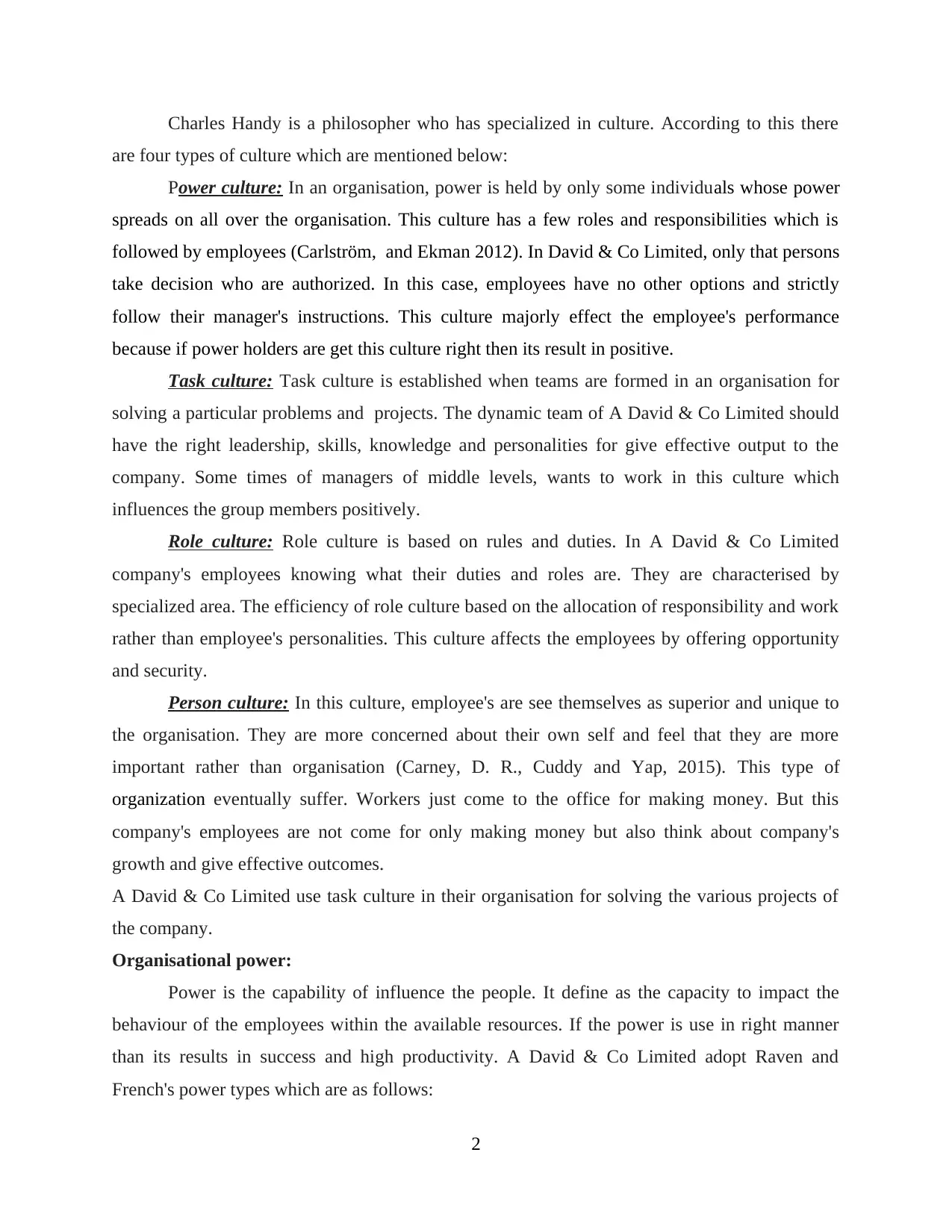
Charles Handy is a philosopher who has specialized in culture. According to this there
are four types of culture which are mentioned below:
Power culture: In an organisation, power is held by only some individuals whose power
spreads on all over the organisation. This culture has a few roles and responsibilities which is
followed by employees (Carlström, and Ekman 2012). In David & Co Limited, only that persons
take decision who are authorized. In this case, employees have no other options and strictly
follow their manager's instructions. This culture majorly effect the employee's performance
because if power holders are get this culture right then its result in positive.
Task culture: Task culture is established when teams are formed in an organisation for
solving a particular problems and projects. The dynamic team of A David & Co Limited should
have the right leadership, skills, knowledge and personalities for give effective output to the
company. Some times of managers of middle levels, wants to work in this culture which
influences the group members positively.
Role culture: Role culture is based on rules and duties. In A David & Co Limited
company's employees knowing what their duties and roles are. They are characterised by
specialized area. The efficiency of role culture based on the allocation of responsibility and work
rather than employee's personalities. This culture affects the employees by offering opportunity
and security.
Person culture: In this culture, employee's are see themselves as superior and unique to
the organisation. They are more concerned about their own self and feel that they are more
important rather than organisation (Carney, D. R., Cuddy and Yap, 2015). This type of
organization eventually suffer. Workers just come to the office for making money. But this
company's employees are not come for only making money but also think about company's
growth and give effective outcomes.
A David & Co Limited use task culture in their organisation for solving the various projects of
the company.
Organisational power:
Power is the capability of influence the people. It define as the capacity to impact the
behaviour of the employees within the available resources. If the power is use in right manner
than its results in success and high productivity. A David & Co Limited adopt Raven and
French's power types which are as follows:
2
are four types of culture which are mentioned below:
Power culture: In an organisation, power is held by only some individuals whose power
spreads on all over the organisation. This culture has a few roles and responsibilities which is
followed by employees (Carlström, and Ekman 2012). In David & Co Limited, only that persons
take decision who are authorized. In this case, employees have no other options and strictly
follow their manager's instructions. This culture majorly effect the employee's performance
because if power holders are get this culture right then its result in positive.
Task culture: Task culture is established when teams are formed in an organisation for
solving a particular problems and projects. The dynamic team of A David & Co Limited should
have the right leadership, skills, knowledge and personalities for give effective output to the
company. Some times of managers of middle levels, wants to work in this culture which
influences the group members positively.
Role culture: Role culture is based on rules and duties. In A David & Co Limited
company's employees knowing what their duties and roles are. They are characterised by
specialized area. The efficiency of role culture based on the allocation of responsibility and work
rather than employee's personalities. This culture affects the employees by offering opportunity
and security.
Person culture: In this culture, employee's are see themselves as superior and unique to
the organisation. They are more concerned about their own self and feel that they are more
important rather than organisation (Carney, D. R., Cuddy and Yap, 2015). This type of
organization eventually suffer. Workers just come to the office for making money. But this
company's employees are not come for only making money but also think about company's
growth and give effective outcomes.
A David & Co Limited use task culture in their organisation for solving the various projects of
the company.
Organisational power:
Power is the capability of influence the people. It define as the capacity to impact the
behaviour of the employees within the available resources. If the power is use in right manner
than its results in success and high productivity. A David & Co Limited adopt Raven and
French's power types which are as follows:
2
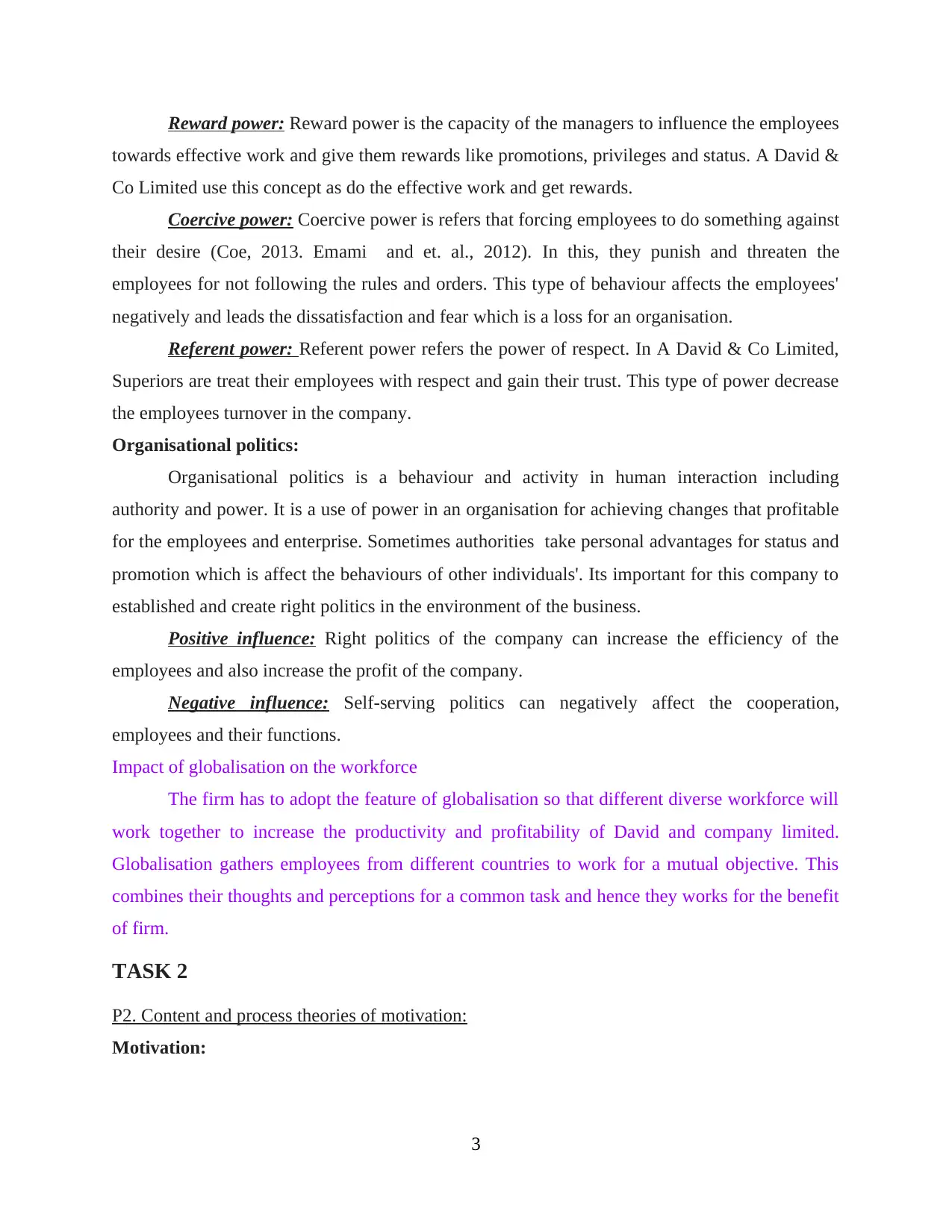
Reward power: Reward power is the capacity of the managers to influence the employees
towards effective work and give them rewards like promotions, privileges and status. A David &
Co Limited use this concept as do the effective work and get rewards.
Coercive power: Coercive power is refers that forcing employees to do something against
their desire (Coe, 2013. Emami and et. al., 2012). In this, they punish and threaten the
employees for not following the rules and orders. This type of behaviour affects the employees'
negatively and leads the dissatisfaction and fear which is a loss for an organisation.
Referent power: Referent power refers the power of respect. In A David & Co Limited,
Superiors are treat their employees with respect and gain their trust. This type of power decrease
the employees turnover in the company.
Organisational politics:
Organisational politics is a behaviour and activity in human interaction including
authority and power. It is a use of power in an organisation for achieving changes that profitable
for the employees and enterprise. Sometimes authorities take personal advantages for status and
promotion which is affect the behaviours of other individuals'. Its important for this company to
established and create right politics in the environment of the business.
Positive influence: Right politics of the company can increase the efficiency of the
employees and also increase the profit of the company.
Negative influence: Self-serving politics can negatively affect the cooperation,
employees and their functions.
Impact of globalisation on the workforce
The firm has to adopt the feature of globalisation so that different diverse workforce will
work together to increase the productivity and profitability of David and company limited.
Globalisation gathers employees from different countries to work for a mutual objective. This
combines their thoughts and perceptions for a common task and hence they works for the benefit
of firm.
TASK 2
P2. Content and process theories of motivation:
Motivation:
3
towards effective work and give them rewards like promotions, privileges and status. A David &
Co Limited use this concept as do the effective work and get rewards.
Coercive power: Coercive power is refers that forcing employees to do something against
their desire (Coe, 2013. Emami and et. al., 2012). In this, they punish and threaten the
employees for not following the rules and orders. This type of behaviour affects the employees'
negatively and leads the dissatisfaction and fear which is a loss for an organisation.
Referent power: Referent power refers the power of respect. In A David & Co Limited,
Superiors are treat their employees with respect and gain their trust. This type of power decrease
the employees turnover in the company.
Organisational politics:
Organisational politics is a behaviour and activity in human interaction including
authority and power. It is a use of power in an organisation for achieving changes that profitable
for the employees and enterprise. Sometimes authorities take personal advantages for status and
promotion which is affect the behaviours of other individuals'. Its important for this company to
established and create right politics in the environment of the business.
Positive influence: Right politics of the company can increase the efficiency of the
employees and also increase the profit of the company.
Negative influence: Self-serving politics can negatively affect the cooperation,
employees and their functions.
Impact of globalisation on the workforce
The firm has to adopt the feature of globalisation so that different diverse workforce will
work together to increase the productivity and profitability of David and company limited.
Globalisation gathers employees from different countries to work for a mutual objective. This
combines their thoughts and perceptions for a common task and hence they works for the benefit
of firm.
TASK 2
P2. Content and process theories of motivation:
Motivation:
3
⊘ This is a preview!⊘
Do you want full access?
Subscribe today to unlock all pages.

Trusted by 1+ million students worldwide
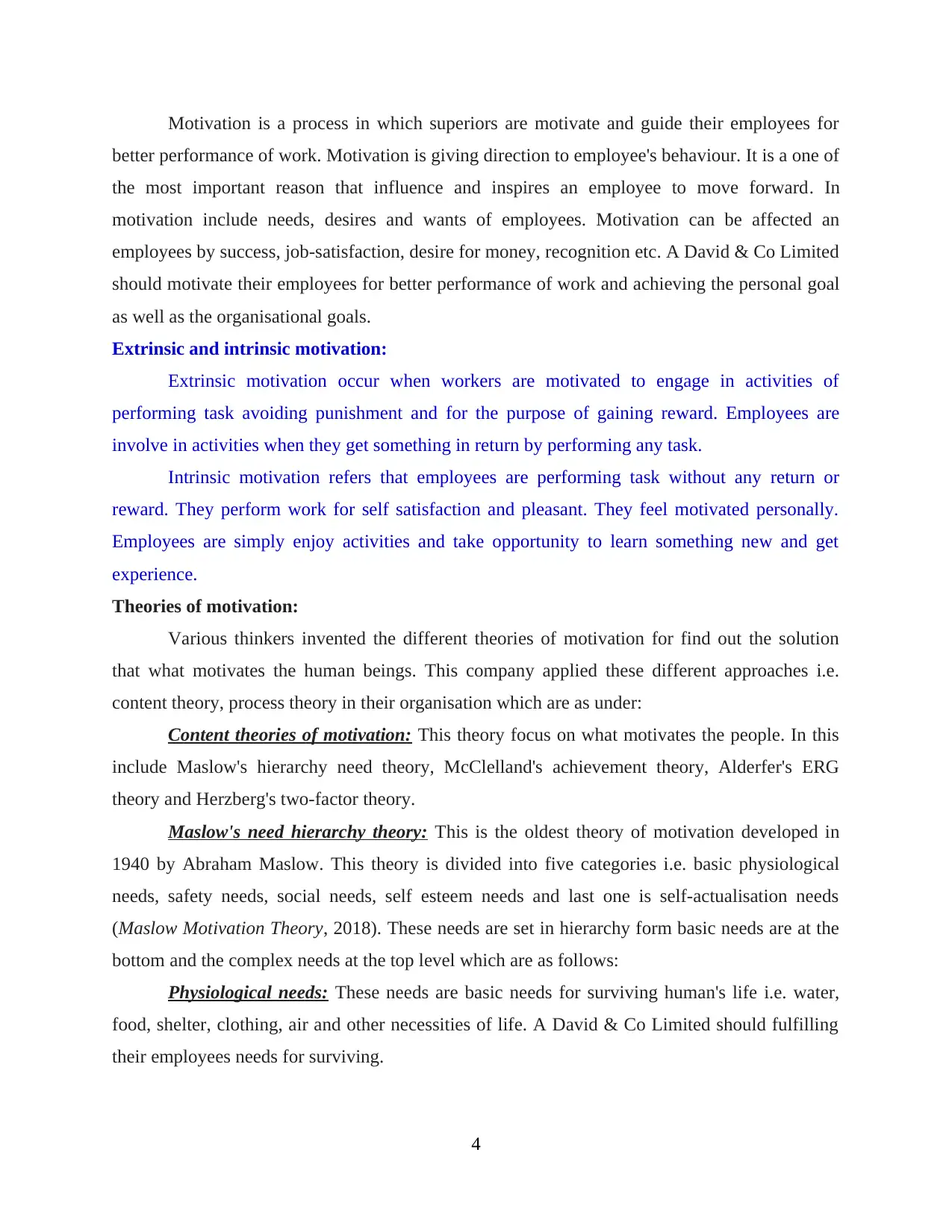
Motivation is a process in which superiors are motivate and guide their employees for
better performance of work. Motivation is giving direction to employee's behaviour. It is a one of
the most important reason that influence and inspires an employee to move forward. In
motivation include needs, desires and wants of employees. Motivation can be affected an
employees by success, job-satisfaction, desire for money, recognition etc. A David & Co Limited
should motivate their employees for better performance of work and achieving the personal goal
as well as the organisational goals.
Extrinsic and intrinsic motivation:
Extrinsic motivation occur when workers are motivated to engage in activities of
performing task avoiding punishment and for the purpose of gaining reward. Employees are
involve in activities when they get something in return by performing any task.
Intrinsic motivation refers that employees are performing task without any return or
reward. They perform work for self satisfaction and pleasant. They feel motivated personally.
Employees are simply enjoy activities and take opportunity to learn something new and get
experience.
Theories of motivation:
Various thinkers invented the different theories of motivation for find out the solution
that what motivates the human beings. This company applied these different approaches i.e.
content theory, process theory in their organisation which are as under:
Content theories of motivation: This theory focus on what motivates the people. In this
include Maslow's hierarchy need theory, McClelland's achievement theory, Alderfer's ERG
theory and Herzberg's two-factor theory.
Maslow's need hierarchy theory: This is the oldest theory of motivation developed in
1940 by Abraham Maslow. This theory is divided into five categories i.e. basic physiological
needs, safety needs, social needs, self esteem needs and last one is self-actualisation needs
(Maslow Motivation Theory, 2018). These needs are set in hierarchy form basic needs are at the
bottom and the complex needs at the top level which are as follows:
Physiological needs: These needs are basic needs for surviving human's life i.e. water,
food, shelter, clothing, air and other necessities of life. A David & Co Limited should fulfilling
their employees needs for surviving.
4
better performance of work. Motivation is giving direction to employee's behaviour. It is a one of
the most important reason that influence and inspires an employee to move forward. In
motivation include needs, desires and wants of employees. Motivation can be affected an
employees by success, job-satisfaction, desire for money, recognition etc. A David & Co Limited
should motivate their employees for better performance of work and achieving the personal goal
as well as the organisational goals.
Extrinsic and intrinsic motivation:
Extrinsic motivation occur when workers are motivated to engage in activities of
performing task avoiding punishment and for the purpose of gaining reward. Employees are
involve in activities when they get something in return by performing any task.
Intrinsic motivation refers that employees are performing task without any return or
reward. They perform work for self satisfaction and pleasant. They feel motivated personally.
Employees are simply enjoy activities and take opportunity to learn something new and get
experience.
Theories of motivation:
Various thinkers invented the different theories of motivation for find out the solution
that what motivates the human beings. This company applied these different approaches i.e.
content theory, process theory in their organisation which are as under:
Content theories of motivation: This theory focus on what motivates the people. In this
include Maslow's hierarchy need theory, McClelland's achievement theory, Alderfer's ERG
theory and Herzberg's two-factor theory.
Maslow's need hierarchy theory: This is the oldest theory of motivation developed in
1940 by Abraham Maslow. This theory is divided into five categories i.e. basic physiological
needs, safety needs, social needs, self esteem needs and last one is self-actualisation needs
(Maslow Motivation Theory, 2018). These needs are set in hierarchy form basic needs are at the
bottom and the complex needs at the top level which are as follows:
Physiological needs: These needs are basic needs for surviving human's life i.e. water,
food, shelter, clothing, air and other necessities of life. A David & Co Limited should fulfilling
their employees needs for surviving.
4
Paraphrase This Document
Need a fresh take? Get an instant paraphrase of this document with our AI Paraphraser
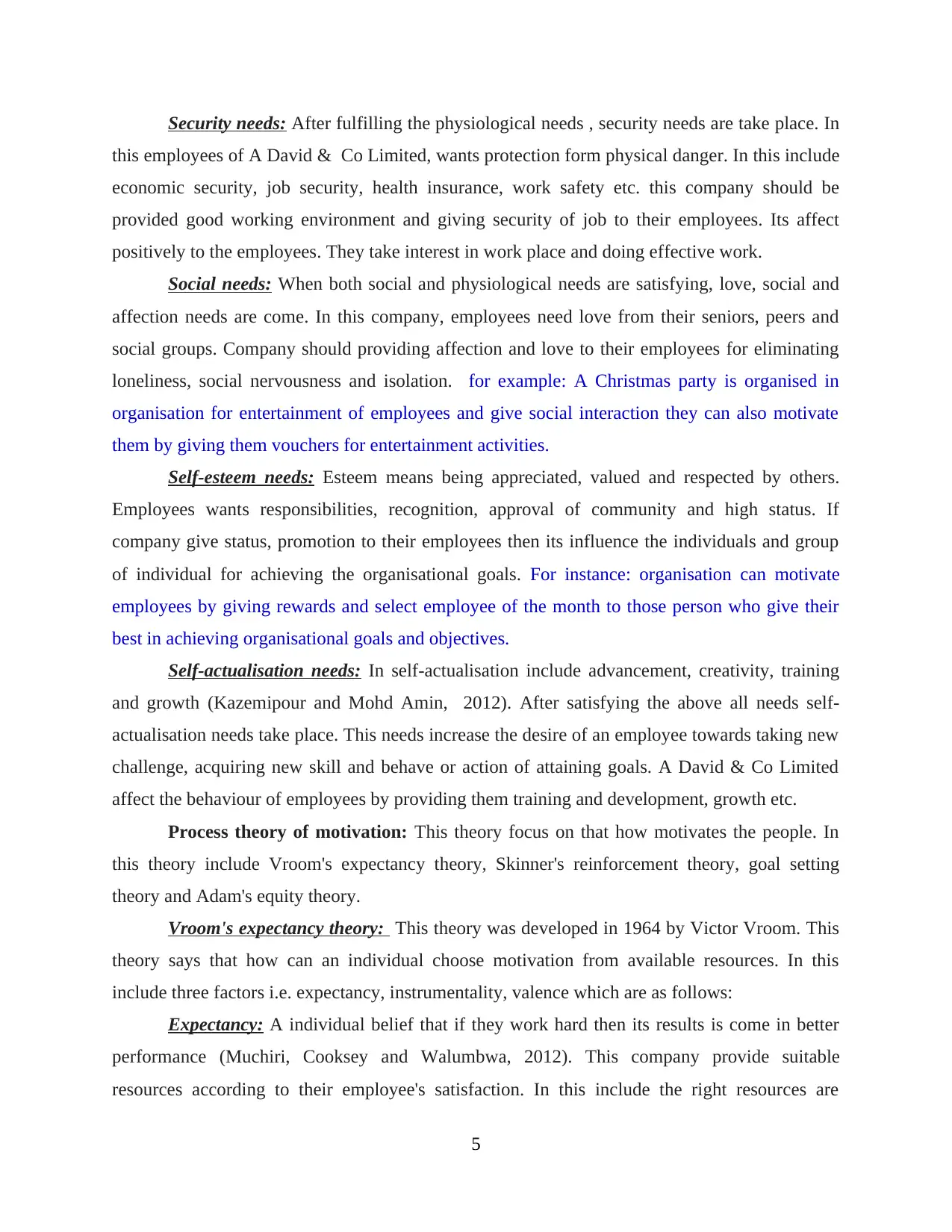
Security needs: After fulfilling the physiological needs , security needs are take place. In
this employees of A David & Co Limited, wants protection form physical danger. In this include
economic security, job security, health insurance, work safety etc. this company should be
provided good working environment and giving security of job to their employees. Its affect
positively to the employees. They take interest in work place and doing effective work.
Social needs: When both social and physiological needs are satisfying, love, social and
affection needs are come. In this company, employees need love from their seniors, peers and
social groups. Company should providing affection and love to their employees for eliminating
loneliness, social nervousness and isolation. for example: A Christmas party is organised in
organisation for entertainment of employees and give social interaction they can also motivate
them by giving them vouchers for entertainment activities.
Self-esteem needs: Esteem means being appreciated, valued and respected by others.
Employees wants responsibilities, recognition, approval of community and high status. If
company give status, promotion to their employees then its influence the individuals and group
of individual for achieving the organisational goals. For instance: organisation can motivate
employees by giving rewards and select employee of the month to those person who give their
best in achieving organisational goals and objectives.
Self-actualisation needs: In self-actualisation include advancement, creativity, training
and growth (Kazemipour and Mohd Amin, 2012). After satisfying the above all needs self-
actualisation needs take place. This needs increase the desire of an employee towards taking new
challenge, acquiring new skill and behave or action of attaining goals. A David & Co Limited
affect the behaviour of employees by providing them training and development, growth etc.
Process theory of motivation: This theory focus on that how motivates the people. In
this theory include Vroom's expectancy theory, Skinner's reinforcement theory, goal setting
theory and Adam's equity theory.
Vroom's expectancy theory: This theory was developed in 1964 by Victor Vroom. This
theory says that how can an individual choose motivation from available resources. In this
include three factors i.e. expectancy, instrumentality, valence which are as follows:
Expectancy: A individual belief that if they work hard then its results is come in better
performance (Muchiri, Cooksey and Walumbwa, 2012). This company provide suitable
resources according to their employee's satisfaction. In this include the right resources are
5
this employees of A David & Co Limited, wants protection form physical danger. In this include
economic security, job security, health insurance, work safety etc. this company should be
provided good working environment and giving security of job to their employees. Its affect
positively to the employees. They take interest in work place and doing effective work.
Social needs: When both social and physiological needs are satisfying, love, social and
affection needs are come. In this company, employees need love from their seniors, peers and
social groups. Company should providing affection and love to their employees for eliminating
loneliness, social nervousness and isolation. for example: A Christmas party is organised in
organisation for entertainment of employees and give social interaction they can also motivate
them by giving them vouchers for entertainment activities.
Self-esteem needs: Esteem means being appreciated, valued and respected by others.
Employees wants responsibilities, recognition, approval of community and high status. If
company give status, promotion to their employees then its influence the individuals and group
of individual for achieving the organisational goals. For instance: organisation can motivate
employees by giving rewards and select employee of the month to those person who give their
best in achieving organisational goals and objectives.
Self-actualisation needs: In self-actualisation include advancement, creativity, training
and growth (Kazemipour and Mohd Amin, 2012). After satisfying the above all needs self-
actualisation needs take place. This needs increase the desire of an employee towards taking new
challenge, acquiring new skill and behave or action of attaining goals. A David & Co Limited
affect the behaviour of employees by providing them training and development, growth etc.
Process theory of motivation: This theory focus on that how motivates the people. In
this theory include Vroom's expectancy theory, Skinner's reinforcement theory, goal setting
theory and Adam's equity theory.
Vroom's expectancy theory: This theory was developed in 1964 by Victor Vroom. This
theory says that how can an individual choose motivation from available resources. In this
include three factors i.e. expectancy, instrumentality, valence which are as follows:
Expectancy: A individual belief that if they work hard then its results is come in better
performance (Muchiri, Cooksey and Walumbwa, 2012). This company provide suitable
resources according to their employee's satisfaction. In this include the right resources are
5
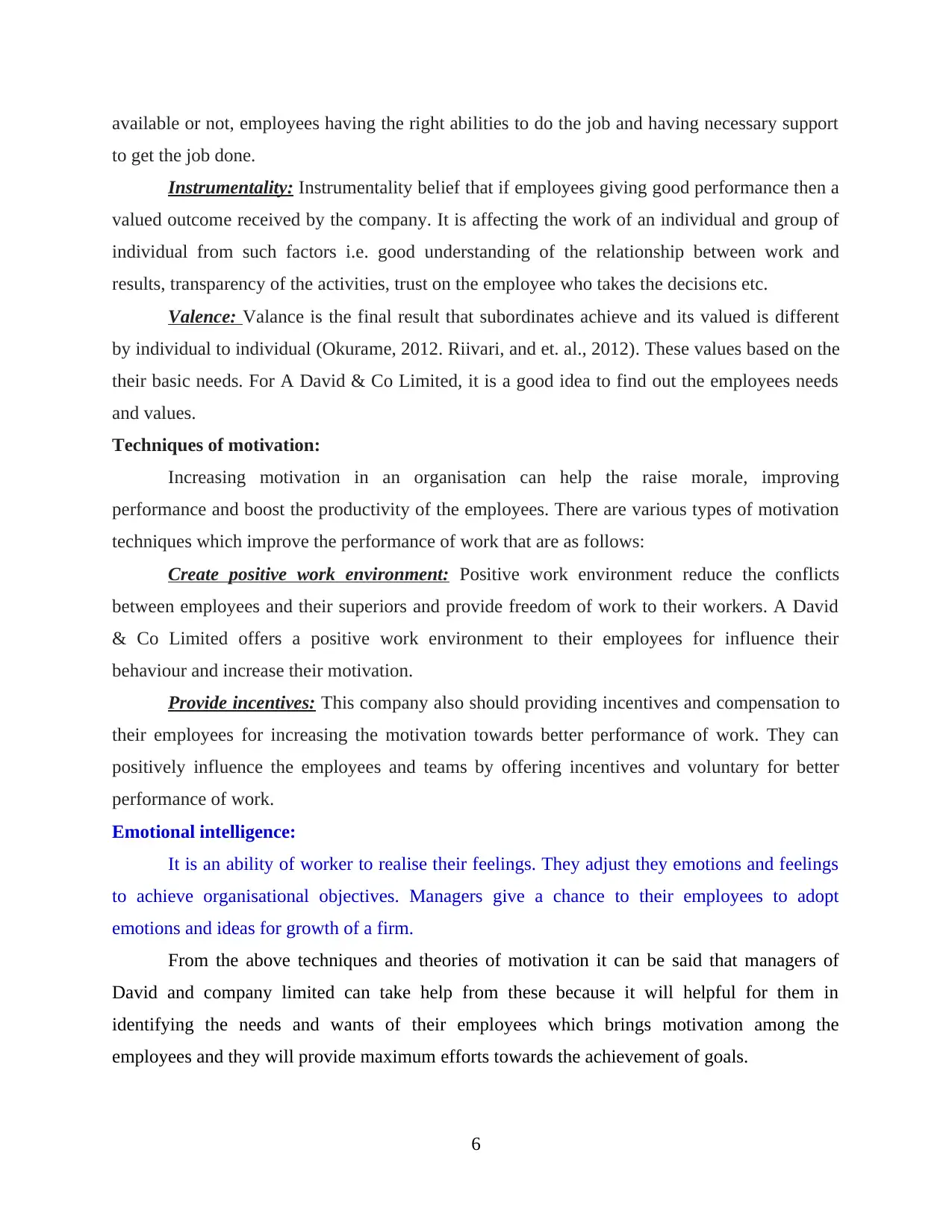
available or not, employees having the right abilities to do the job and having necessary support
to get the job done.
Instrumentality: Instrumentality belief that if employees giving good performance then a
valued outcome received by the company. It is affecting the work of an individual and group of
individual from such factors i.e. good understanding of the relationship between work and
results, transparency of the activities, trust on the employee who takes the decisions etc.
Valence: Valance is the final result that subordinates achieve and its valued is different
by individual to individual (Okurame, 2012. Riivari, and et. al., 2012). These values based on the
their basic needs. For A David & Co Limited, it is a good idea to find out the employees needs
and values.
Techniques of motivation:
Increasing motivation in an organisation can help the raise morale, improving
performance and boost the productivity of the employees. There are various types of motivation
techniques which improve the performance of work that are as follows:
Create positive work environment: Positive work environment reduce the conflicts
between employees and their superiors and provide freedom of work to their workers. A David
& Co Limited offers a positive work environment to their employees for influence their
behaviour and increase their motivation.
Provide incentives: This company also should providing incentives and compensation to
their employees for increasing the motivation towards better performance of work. They can
positively influence the employees and teams by offering incentives and voluntary for better
performance of work.
Emotional intelligence:
It is an ability of worker to realise their feelings. They adjust they emotions and feelings
to achieve organisational objectives. Managers give a chance to their employees to adopt
emotions and ideas for growth of a firm.
From the above techniques and theories of motivation it can be said that managers of
David and company limited can take help from these because it will helpful for them in
identifying the needs and wants of their employees which brings motivation among the
employees and they will provide maximum efforts towards the achievement of goals.
6
to get the job done.
Instrumentality: Instrumentality belief that if employees giving good performance then a
valued outcome received by the company. It is affecting the work of an individual and group of
individual from such factors i.e. good understanding of the relationship between work and
results, transparency of the activities, trust on the employee who takes the decisions etc.
Valence: Valance is the final result that subordinates achieve and its valued is different
by individual to individual (Okurame, 2012. Riivari, and et. al., 2012). These values based on the
their basic needs. For A David & Co Limited, it is a good idea to find out the employees needs
and values.
Techniques of motivation:
Increasing motivation in an organisation can help the raise morale, improving
performance and boost the productivity of the employees. There are various types of motivation
techniques which improve the performance of work that are as follows:
Create positive work environment: Positive work environment reduce the conflicts
between employees and their superiors and provide freedom of work to their workers. A David
& Co Limited offers a positive work environment to their employees for influence their
behaviour and increase their motivation.
Provide incentives: This company also should providing incentives and compensation to
their employees for increasing the motivation towards better performance of work. They can
positively influence the employees and teams by offering incentives and voluntary for better
performance of work.
Emotional intelligence:
It is an ability of worker to realise their feelings. They adjust they emotions and feelings
to achieve organisational objectives. Managers give a chance to their employees to adopt
emotions and ideas for growth of a firm.
From the above techniques and theories of motivation it can be said that managers of
David and company limited can take help from these because it will helpful for them in
identifying the needs and wants of their employees which brings motivation among the
employees and they will provide maximum efforts towards the achievement of goals.
6
⊘ This is a preview!⊘
Do you want full access?
Subscribe today to unlock all pages.

Trusted by 1+ million students worldwide
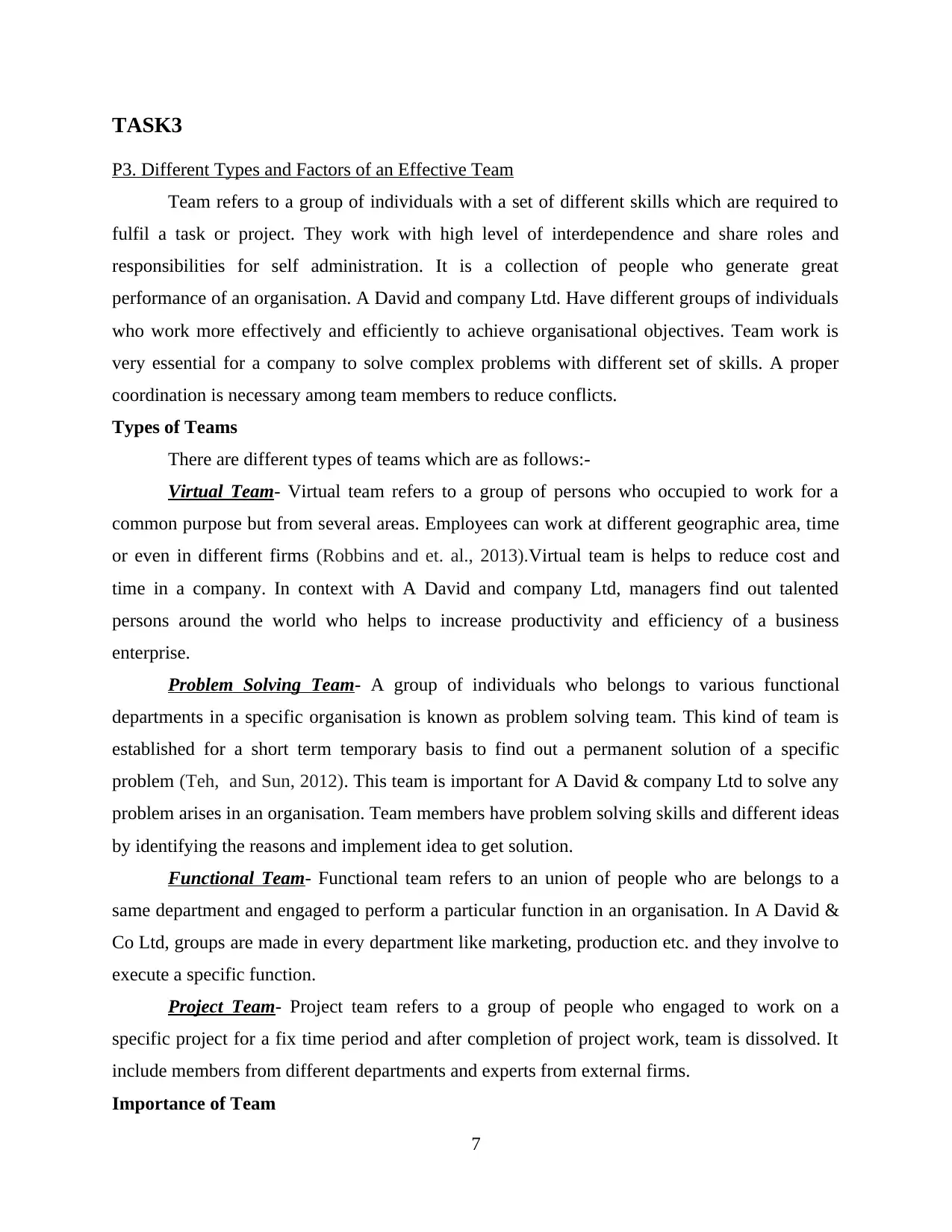
TASK3
P3. Different Types and Factors of an Effective Team
Team refers to a group of individuals with a set of different skills which are required to
fulfil a task or project. They work with high level of interdependence and share roles and
responsibilities for self administration. It is a collection of people who generate great
performance of an organisation. A David and company Ltd. Have different groups of individuals
who work more effectively and efficiently to achieve organisational objectives. Team work is
very essential for a company to solve complex problems with different set of skills. A proper
coordination is necessary among team members to reduce conflicts.
Types of Teams
There are different types of teams which are as follows:-
Virtual Team- Virtual team refers to a group of persons who occupied to work for a
common purpose but from several areas. Employees can work at different geographic area, time
or even in different firms (Robbins and et. al., 2013).Virtual team is helps to reduce cost and
time in a company. In context with A David and company Ltd, managers find out talented
persons around the world who helps to increase productivity and efficiency of a business
enterprise.
Problem Solving Team- A group of individuals who belongs to various functional
departments in a specific organisation is known as problem solving team. This kind of team is
established for a short term temporary basis to find out a permanent solution of a specific
problem (Teh, and Sun, 2012). This team is important for A David & company Ltd to solve any
problem arises in an organisation. Team members have problem solving skills and different ideas
by identifying the reasons and implement idea to get solution.
Functional Team- Functional team refers to an union of people who are belongs to a
same department and engaged to perform a particular function in an organisation. In A David &
Co Ltd, groups are made in every department like marketing, production etc. and they involve to
execute a specific function.
Project Team- Project team refers to a group of people who engaged to work on a
specific project for a fix time period and after completion of project work, team is dissolved. It
include members from different departments and experts from external firms.
Importance of Team
7
P3. Different Types and Factors of an Effective Team
Team refers to a group of individuals with a set of different skills which are required to
fulfil a task or project. They work with high level of interdependence and share roles and
responsibilities for self administration. It is a collection of people who generate great
performance of an organisation. A David and company Ltd. Have different groups of individuals
who work more effectively and efficiently to achieve organisational objectives. Team work is
very essential for a company to solve complex problems with different set of skills. A proper
coordination is necessary among team members to reduce conflicts.
Types of Teams
There are different types of teams which are as follows:-
Virtual Team- Virtual team refers to a group of persons who occupied to work for a
common purpose but from several areas. Employees can work at different geographic area, time
or even in different firms (Robbins and et. al., 2013).Virtual team is helps to reduce cost and
time in a company. In context with A David and company Ltd, managers find out talented
persons around the world who helps to increase productivity and efficiency of a business
enterprise.
Problem Solving Team- A group of individuals who belongs to various functional
departments in a specific organisation is known as problem solving team. This kind of team is
established for a short term temporary basis to find out a permanent solution of a specific
problem (Teh, and Sun, 2012). This team is important for A David & company Ltd to solve any
problem arises in an organisation. Team members have problem solving skills and different ideas
by identifying the reasons and implement idea to get solution.
Functional Team- Functional team refers to an union of people who are belongs to a
same department and engaged to perform a particular function in an organisation. In A David &
Co Ltd, groups are made in every department like marketing, production etc. and they involve to
execute a specific function.
Project Team- Project team refers to a group of people who engaged to work on a
specific project for a fix time period and after completion of project work, team is dissolved. It
include members from different departments and experts from external firms.
Importance of Team
7
Paraphrase This Document
Need a fresh take? Get an instant paraphrase of this document with our AI Paraphraser
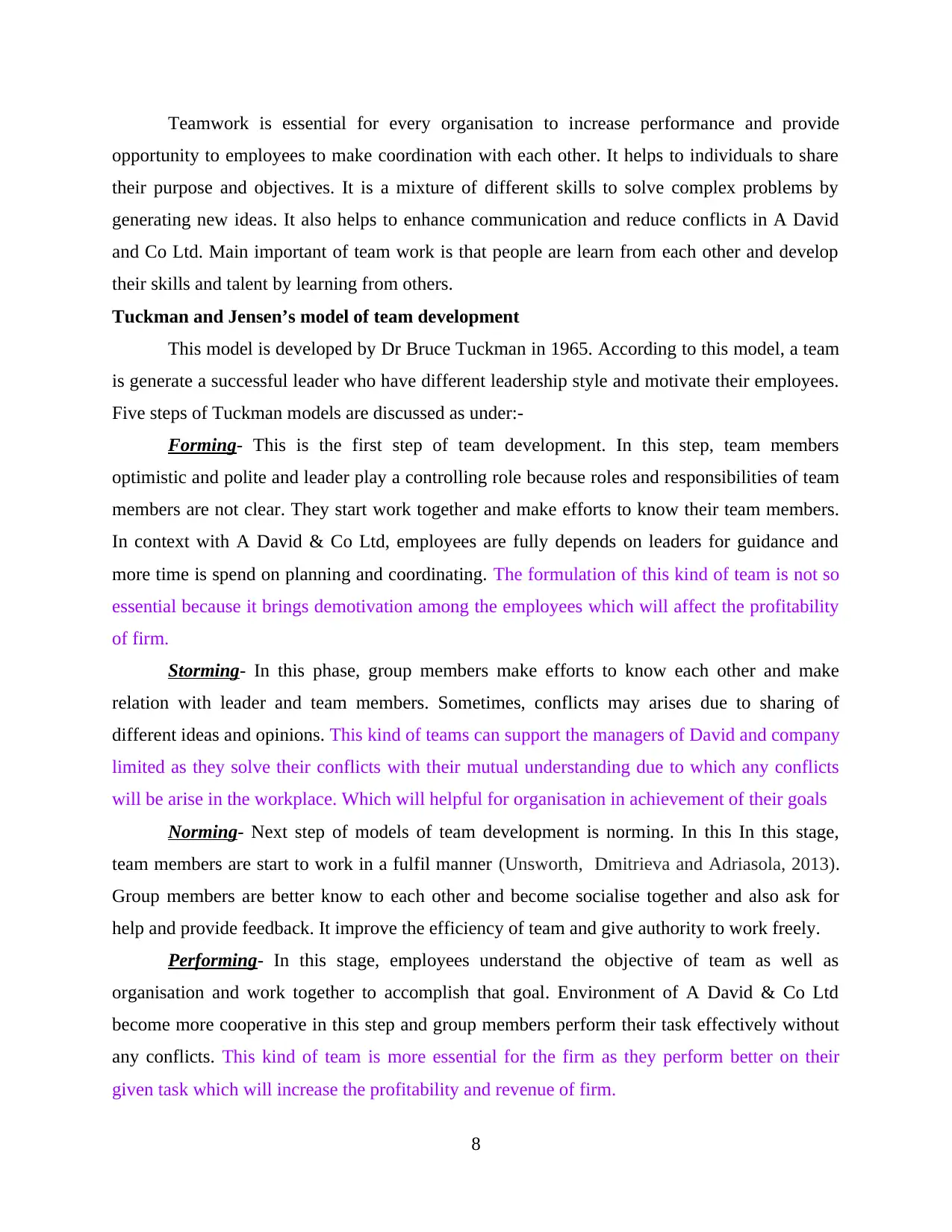
Teamwork is essential for every organisation to increase performance and provide
opportunity to employees to make coordination with each other. It helps to individuals to share
their purpose and objectives. It is a mixture of different skills to solve complex problems by
generating new ideas. It also helps to enhance communication and reduce conflicts in A David
and Co Ltd. Main important of team work is that people are learn from each other and develop
their skills and talent by learning from others.
Tuckman and Jensen’s model of team development
This model is developed by Dr Bruce Tuckman in 1965. According to this model, a team
is generate a successful leader who have different leadership style and motivate their employees.
Five steps of Tuckman models are discussed as under:-
Forming- This is the first step of team development. In this step, team members
optimistic and polite and leader play a controlling role because roles and responsibilities of team
members are not clear. They start work together and make efforts to know their team members.
In context with A David & Co Ltd, employees are fully depends on leaders for guidance and
more time is spend on planning and coordinating. The formulation of this kind of team is not so
essential because it brings demotivation among the employees which will affect the profitability
of firm.
Storming- In this phase, group members make efforts to know each other and make
relation with leader and team members. Sometimes, conflicts may arises due to sharing of
different ideas and opinions. This kind of teams can support the managers of David and company
limited as they solve their conflicts with their mutual understanding due to which any conflicts
will be arise in the workplace. Which will helpful for organisation in achievement of their goals
Norming- Next step of models of team development is norming. In this In this stage,
team members are start to work in a fulfil manner (Unsworth, Dmitrieva and Adriasola, 2013).
Group members are better know to each other and become socialise together and also ask for
help and provide feedback. It improve the efficiency of team and give authority to work freely.
Performing- In this stage, employees understand the objective of team as well as
organisation and work together to accomplish that goal. Environment of A David & Co Ltd
become more cooperative in this step and group members perform their task effectively without
any conflicts. This kind of team is more essential for the firm as they perform better on their
given task which will increase the profitability and revenue of firm.
8
opportunity to employees to make coordination with each other. It helps to individuals to share
their purpose and objectives. It is a mixture of different skills to solve complex problems by
generating new ideas. It also helps to enhance communication and reduce conflicts in A David
and Co Ltd. Main important of team work is that people are learn from each other and develop
their skills and talent by learning from others.
Tuckman and Jensen’s model of team development
This model is developed by Dr Bruce Tuckman in 1965. According to this model, a team
is generate a successful leader who have different leadership style and motivate their employees.
Five steps of Tuckman models are discussed as under:-
Forming- This is the first step of team development. In this step, team members
optimistic and polite and leader play a controlling role because roles and responsibilities of team
members are not clear. They start work together and make efforts to know their team members.
In context with A David & Co Ltd, employees are fully depends on leaders for guidance and
more time is spend on planning and coordinating. The formulation of this kind of team is not so
essential because it brings demotivation among the employees which will affect the profitability
of firm.
Storming- In this phase, group members make efforts to know each other and make
relation with leader and team members. Sometimes, conflicts may arises due to sharing of
different ideas and opinions. This kind of teams can support the managers of David and company
limited as they solve their conflicts with their mutual understanding due to which any conflicts
will be arise in the workplace. Which will helpful for organisation in achievement of their goals
Norming- Next step of models of team development is norming. In this In this stage,
team members are start to work in a fulfil manner (Unsworth, Dmitrieva and Adriasola, 2013).
Group members are better know to each other and become socialise together and also ask for
help and provide feedback. It improve the efficiency of team and give authority to work freely.
Performing- In this stage, employees understand the objective of team as well as
organisation and work together to accomplish that goal. Environment of A David & Co Ltd
become more cooperative in this step and group members perform their task effectively without
any conflicts. This kind of team is more essential for the firm as they perform better on their
given task which will increase the profitability and revenue of firm.
8
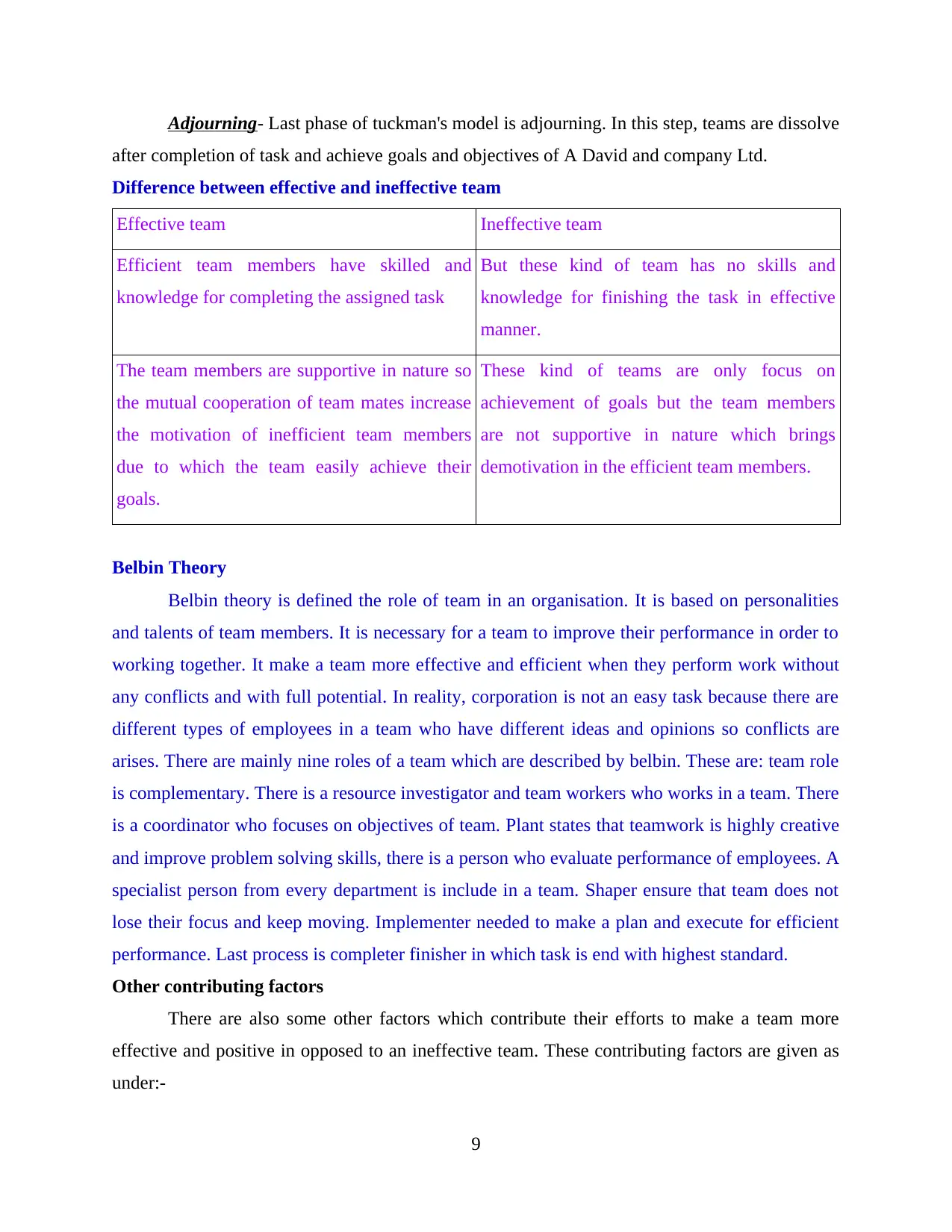
Adjourning- Last phase of tuckman's model is adjourning. In this step, teams are dissolve
after completion of task and achieve goals and objectives of A David and company Ltd.
Difference between effective and ineffective team
Effective team Ineffective team
Efficient team members have skilled and
knowledge for completing the assigned task
But these kind of team has no skills and
knowledge for finishing the task in effective
manner.
The team members are supportive in nature so
the mutual cooperation of team mates increase
the motivation of inefficient team members
due to which the team easily achieve their
goals.
These kind of teams are only focus on
achievement of goals but the team members
are not supportive in nature which brings
demotivation in the efficient team members.
Belbin Theory
Belbin theory is defined the role of team in an organisation. It is based on personalities
and talents of team members. It is necessary for a team to improve their performance in order to
working together. It make a team more effective and efficient when they perform work without
any conflicts and with full potential. In reality, corporation is not an easy task because there are
different types of employees in a team who have different ideas and opinions so conflicts are
arises. There are mainly nine roles of a team which are described by belbin. These are: team role
is complementary. There is a resource investigator and team workers who works in a team. There
is a coordinator who focuses on objectives of team. Plant states that teamwork is highly creative
and improve problem solving skills, there is a person who evaluate performance of employees. A
specialist person from every department is include in a team. Shaper ensure that team does not
lose their focus and keep moving. Implementer needed to make a plan and execute for efficient
performance. Last process is completer finisher in which task is end with highest standard.
Other contributing factors
There are also some other factors which contribute their efforts to make a team more
effective and positive in opposed to an ineffective team. These contributing factors are given as
under:-
9
after completion of task and achieve goals and objectives of A David and company Ltd.
Difference between effective and ineffective team
Effective team Ineffective team
Efficient team members have skilled and
knowledge for completing the assigned task
But these kind of team has no skills and
knowledge for finishing the task in effective
manner.
The team members are supportive in nature so
the mutual cooperation of team mates increase
the motivation of inefficient team members
due to which the team easily achieve their
goals.
These kind of teams are only focus on
achievement of goals but the team members
are not supportive in nature which brings
demotivation in the efficient team members.
Belbin Theory
Belbin theory is defined the role of team in an organisation. It is based on personalities
and talents of team members. It is necessary for a team to improve their performance in order to
working together. It make a team more effective and efficient when they perform work without
any conflicts and with full potential. In reality, corporation is not an easy task because there are
different types of employees in a team who have different ideas and opinions so conflicts are
arises. There are mainly nine roles of a team which are described by belbin. These are: team role
is complementary. There is a resource investigator and team workers who works in a team. There
is a coordinator who focuses on objectives of team. Plant states that teamwork is highly creative
and improve problem solving skills, there is a person who evaluate performance of employees. A
specialist person from every department is include in a team. Shaper ensure that team does not
lose their focus and keep moving. Implementer needed to make a plan and execute for efficient
performance. Last process is completer finisher in which task is end with highest standard.
Other contributing factors
There are also some other factors which contribute their efforts to make a team more
effective and positive in opposed to an ineffective team. These contributing factors are given as
under:-
9
⊘ This is a preview!⊘
Do you want full access?
Subscribe today to unlock all pages.

Trusted by 1+ million students worldwide
1 out of 17
Related Documents
Your All-in-One AI-Powered Toolkit for Academic Success.
+13062052269
info@desklib.com
Available 24*7 on WhatsApp / Email
![[object Object]](/_next/static/media/star-bottom.7253800d.svg)
Unlock your academic potential
Copyright © 2020–2025 A2Z Services. All Rights Reserved. Developed and managed by ZUCOL.





